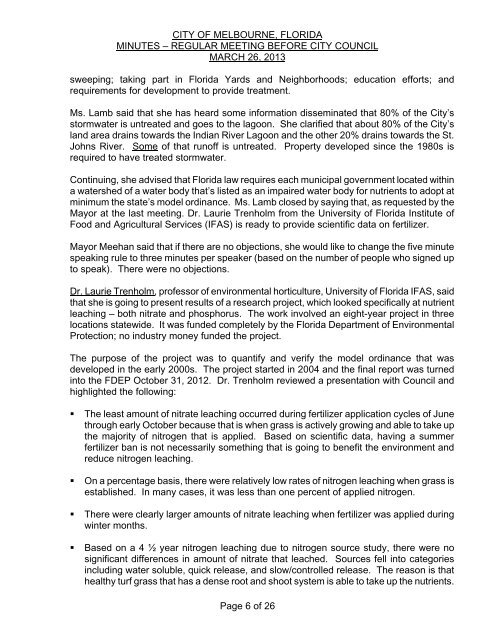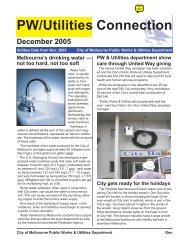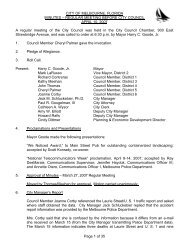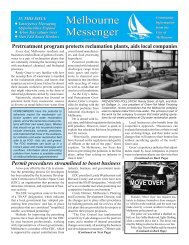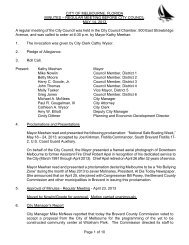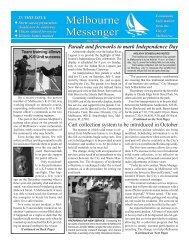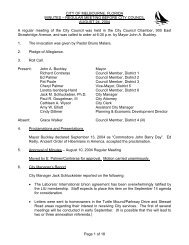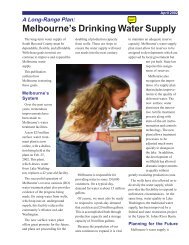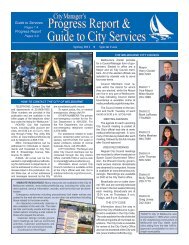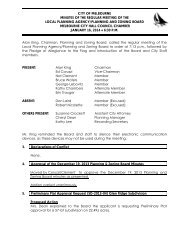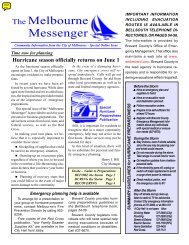March 26 - City of Melbourne, Florida
March 26 - City of Melbourne, Florida
March 26 - City of Melbourne, Florida
You also want an ePaper? Increase the reach of your titles
YUMPU automatically turns print PDFs into web optimized ePapers that Google loves.
CITY OF MELBOURNE, FLORIDA<br />
MINUTES – REGULAR MEETING BEFORE CITY COUNCIL<br />
MARCH <strong>26</strong>, 2013<br />
sweeping; taking part in <strong>Florida</strong> Yards and Neighborhoods; education efforts; and<br />
requirements for development to provide treatment.<br />
Ms. Lamb said that she has heard some information disseminated that 80% <strong>of</strong> the <strong>City</strong>’s<br />
stormwater is untreated and goes to the lagoon. She clarified that about 80% <strong>of</strong> the <strong>City</strong>’s<br />
land area drains towards the Indian River Lagoon and the other 20% drains towards the St.<br />
Johns River. Some <strong>of</strong> that run<strong>of</strong>f is untreated. Property developed since the 1980s is<br />
required to have treated stormwater.<br />
Continuing, she advised that <strong>Florida</strong> law requires each municipal government located within<br />
a watershed <strong>of</strong> a water body that’s listed as an impaired water body for nutrients to adopt at<br />
minimum the state’s model ordinance. Ms. Lamb closed by saying that, as requested by the<br />
Mayor at the last meeting. Dr. Laurie Trenholm from the University <strong>of</strong> <strong>Florida</strong> Institute <strong>of</strong><br />
Food and Agricultural Services (IFAS) is ready to provide scientific data on fertilizer.<br />
Mayor Meehan said that if there are no objections, she would like to change the five minute<br />
speaking rule to three minutes per speaker (based on the number <strong>of</strong> people who signed up<br />
to speak). There were no objections.<br />
Dr. Laurie Trenholm, pr<strong>of</strong>essor <strong>of</strong> environmental horticulture, University <strong>of</strong> <strong>Florida</strong> IFAS, said<br />
that she is going to present results <strong>of</strong> a research project, which looked specifically at nutrient<br />
leaching – both nitrate and phosphorus. The work involved an eight-year project in three<br />
locations statewide. It was funded completely by the <strong>Florida</strong> Department <strong>of</strong> Environmental<br />
Protection; no industry money funded the project.<br />
The purpose <strong>of</strong> the project was to quantify and verify the model ordinance that was<br />
developed in the early 2000s. The project started in 2004 and the final report was turned<br />
into the FDEP October 31, 2012. Dr. Trenholm reviewed a presentation with Council and<br />
highlighted the following:<br />
• The least amount <strong>of</strong> nitrate leaching occurred during fertilizer application cycles <strong>of</strong> June<br />
through early October because that is when grass is actively growing and able to take up<br />
the majority <strong>of</strong> nitrogen that is applied. Based on scientific data, having a summer<br />
fertilizer ban is not necessarily something that is going to benefit the environment and<br />
reduce nitrogen leaching.<br />
• On a percentage basis, there were relatively low rates <strong>of</strong> nitrogen leaching when grass is<br />
established. In many cases, it was less than one percent <strong>of</strong> applied nitrogen.<br />
• There were clearly larger amounts <strong>of</strong> nitrate leaching when fertilizer was applied during<br />
winter months.<br />
• Based on a 4 ½ year nitrogen leaching due to nitrogen source study, there were no<br />
significant differences in amount <strong>of</strong> nitrate that leached. Sources fell into categories<br />
including water soluble, quick release, and slow/controlled release. The reason is that<br />
healthy turf grass that has a dense root and shoot system is able to take up the nutrients.<br />
Page 6 <strong>of</strong> <strong>26</strong>


